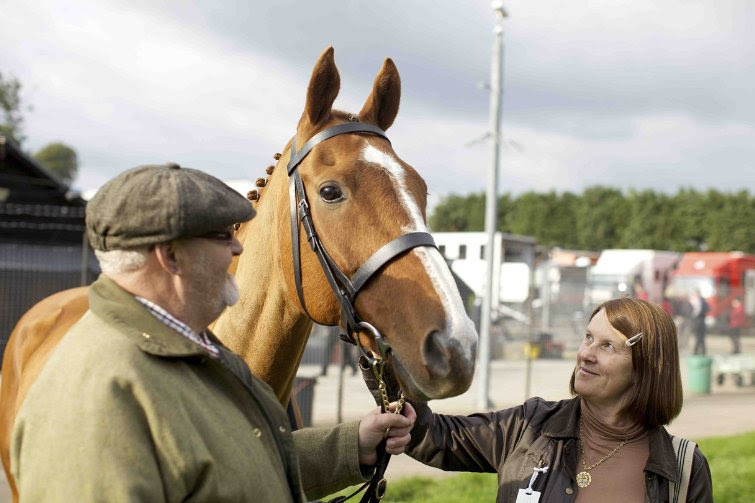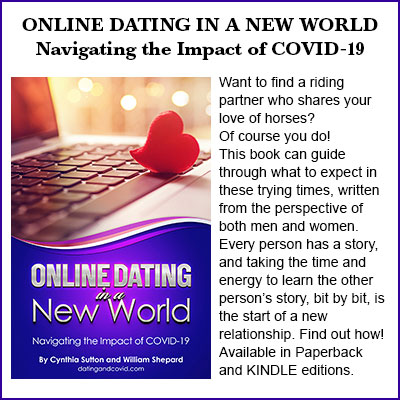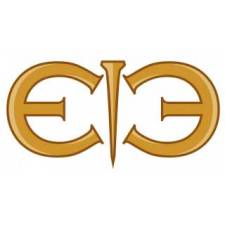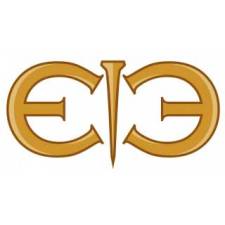
Movie review by Patricia N. Saffran
Dark Horse won the World Cinema Documentary category at the Sundance Film Festival 2015. The film is currently being screened in theaters around the US and a non-US format is offered on Amazon. It is beautifully made and is a joy to watch.
Dream Alliance is the name of a flashy chestnut Thoroughbred born in Cefn Fforest, South Wales, who is the subject of an absorbing documentary written and directed by Louise Osmond. London based Ms. Osmond told her producer that she wanted to do a film about a horse, and he gave her the task of doing a documentary about Dream Alliance, or Dream, his stable name. Ms. Osmond says that she relished the assignment. Cefn Fforest is a small town in an area of closed coal mines that had been operating in the 19th and 20th centuries. The mines had a troubled history of strikes, low wages, ill health, and finally closings. Less known, and not in the film, is that as many as 70,000 pit ponies, as well as donkeys and mules, were once stabled underground to haul coal. They only came out once per year for a festival. Reports on their treatment and survival rates vary greatly, with some equines lasting just several years. The four pits that surrounded Cefn Fforest closed between 1977 to 1989, which left the town with very little hope. I have seen mining towns in South Wales and noticed that they are bleak yet atmospheric, with a strange beauty. It is also an area where people feel the effects from hard labor and the lack of appreciation for it.
Enter Jan Volkes, who unwittingly energized Cefn Fforest with her idea to breed a Thoroughbred. Jan says,“We were a tight knit community as most coal mining towns are. Most of the people were in the pit or connected to the coal mining industry.” She was working two jobs, and still works as a cleaning lady at the local Asda. In 2000, she was also working as a bartender at night. At the bar, she overheard Howard Davies, a tax advisor, talking about a race horse that he once had owned. Jan explains that as a small child she watched her father breed prize parakeets. She says that he wanted some with better color, a fuller chest or a longer tail, and Jan says the lessons in breeding stuck with her. The family then bred racing pigeons, and she won a race with them. Jan next went on to breed whippets, and was successful once again, breeding champions. Jan married early, and had children. In the back of her mind she wanted to have something that was her own, her own area of expertise or accomplishment. Jan says about hearing Howard Davis talk about his horse, “I did a bit of research,” and then she just went to Howard and exclaimed, “I’m going to breed a racehorse.” Howard said, “Good luck,” ironically, because he had only lost money. Jan next spoke to her husband Brian “Daisy” Volkes, and said that she wanted to buy a Thoroughbred mare to breed a racehorse. He explained on camera, “If Jan said she was going to do something, I knew she would do it.” Jan surmised that she was going against the racing crowd who are mostly wealthy or upper class. She says, “One thing I knew about racing is that they like to keep us commoners out . . . I needed to find [a broodmare who was] cheap and cheerful.”
Jan asked Howard Davies to be the head of her racing alliance, and then asked other town people to join and chip in $10 a week toward the venture. Twenty-three people then formed a syndicate that they called the Alliance Partnership. Jan then went about choosing a broodmare. Jan’s choice was a local mare valued at $1000. The mare Rewbell had never won any money, and was fractious and unridable as well. Jan’s husband Daisy, seeing barbed wire injuries from the paddock, negotiated her price down to $350. Jan mated Rewbell to the best stallion at stud nearby that she could afford, a Hollywood Park prize winner, USA born Bien Bien, for $3000. I asked Jan if she did research on the pedigrees of the two horses as it was not clear in the film. She answered, “I researched Bien Bien for breathing problems and anything that could be passed on to his foals. Rewbell was an older mare so I couldn’t find any information on her.”
On March 23, 2001, Rewbell had her foal in a shed built by Jan’s husband, Daisy, on a slag heap. After a meeting, the alliance voted to name the colt Dream Alliance, after their syndicate. Apparently, the youngster was very friendly. Jan says, “He’d come up to you sniffing and he’d follow you around. He wasn’t a bit shy.” As a yearling Dream was brought to a local stable to learn his first racing manners. Jan had him gelded at 18 months because she explains, “He didn’t have a pedigree good enough to use as a stallion.” When Dream was three years old, they had enough funds to bring him to a top local trainer, Philip Hobbs. Howard says, “He was a working class horse about to take on the best.” Daisy assessed the new surroundings for the colt, “When we saw how posh it was compared to where we were, we couldn’t believe it.” The horse’s training over hurdles began in earnest and at his first race, as a three year old, that he entered on November 10, 2004, he came in fourth. In successive races, he finished third, second and then in 2006 Dream won at Chepstow. Dream hit a slump but came back to win the Perth Gold Cup in 2007. The horse came in second to the champion Denman in the Hennessy Gold Cup at Newbury in December 2007. Then at a prep race to the Grand National at Aintree in 2008, Dream severed a tendon. Only the fast action of his jockey, Tom O’Brien, and the instructions from Howard Davies to the vet to save the horse’s life whether or not he could race in the future, prevented the horse from being put down. Dream’s $20,000 winnings were unanimously voted by the syndicate to be used for expensive stem cell surgery at Liverpool Veterinary Hospital, and for fifteen months of rehabilitation. One member says, “The money belongs to the horse. He’s one of the syndicate.” All through his racing career, the Volkes, Howard Davis and other alliance members visited Dream, and they watched his progress, training to come back from his injury. Their affection for the horse was very touching to observe.
Finally, Dream was pronounced fit to race. Hobbs entered him in the Welsh Grand National. This race is truly important to the Welsh. It was first run in 1949 and won by Welsh-born author Dick Francis on Fighting Line. In the film, alliance members are shown in the paddock at the race, enjoying their new found status as Thoroughbred owners, mixing with the wealthier owners. To the surprise of the syndicate, Dream won and all were ecstatic. Winning jockey Tom O’Brien who had also been injured states, “Amazing. I’ve only had about 12 rides since I came back. I had a couple of seconds and thirds and I thought I was doing something wrong, but this horse is a courageous animal. I broke my leg when a horse reared over on top of me and I was out for a couple of months, but this makes it all worthwhile. I love this game. I enjoy every day of it.” Assistant trainer to Philip Hobbs, Johnson White says of Dream coming in first, “I was hugely proud of him, after all the hours of training.” Dream’s win was also triumph for veterinary medicine in that he was one of the first horses to win after receiving stem cell surgery. The movie covers a further health development for Dream and his subsequent races. At the end of his racing career, Dream earned a total of $138,646, and after all expenses returned $1430 net profit to each of the 23 syndicate members. Dark Horse won the World Cinema Documentary category at the Sundance Film Festival 2015. The film is currently being screened in theaters around the US and a non-US format is offered on Amazon. It is beautifully made and is a joy to watch.
Note: Jan has been active with the Alliance Partnership. They purchased a new broodmare named Juwireya, out of Nayef, that Jan had mated with Schiaparelli, out of Monsun. The mare produced a foal on May 10, 2015, that they named Impossible Dream, with Rodney or Roggers as his stable name. The alliance is hoping for another success story with Rodney, and a sequel movie that could be called Impossible Dream.












